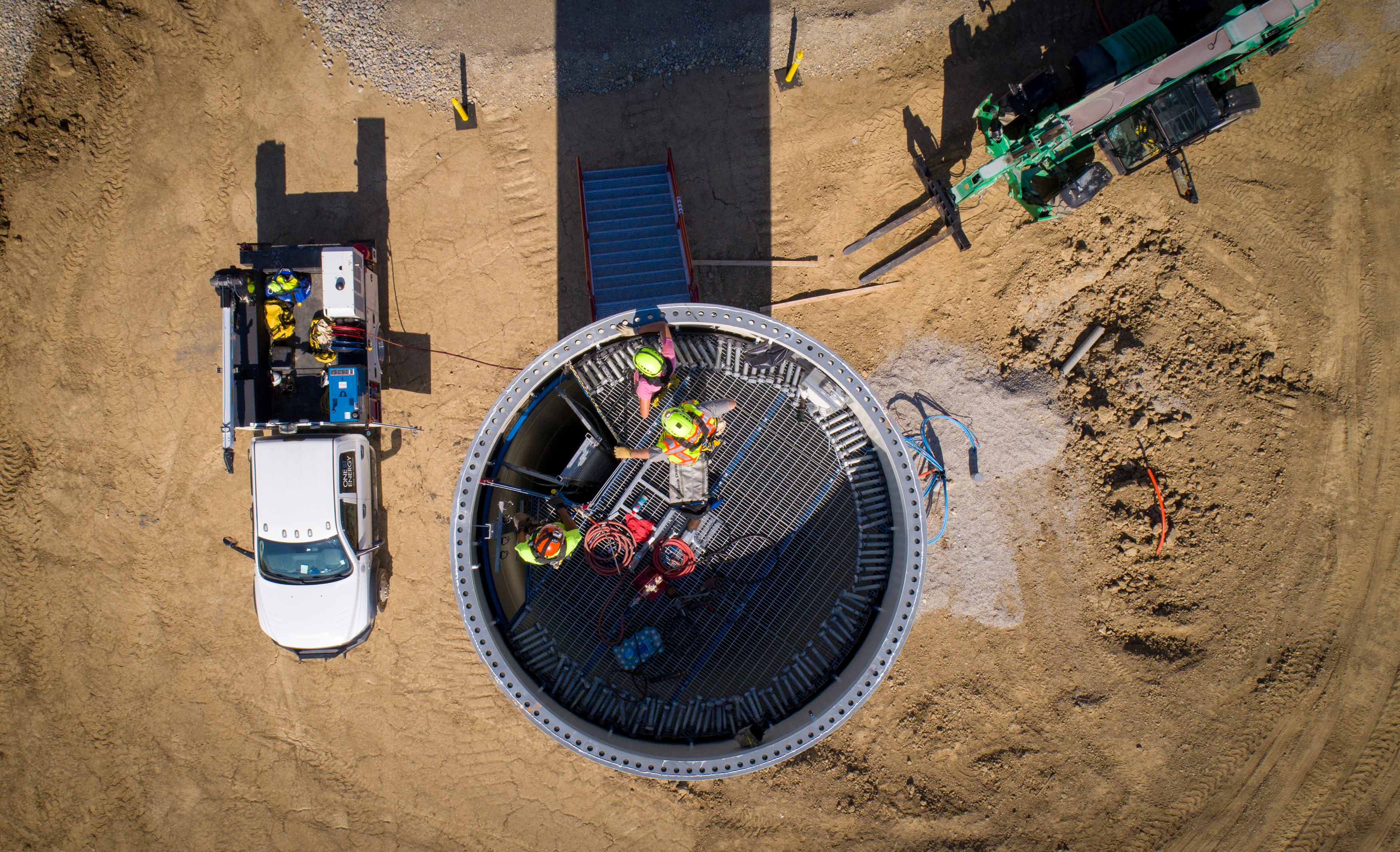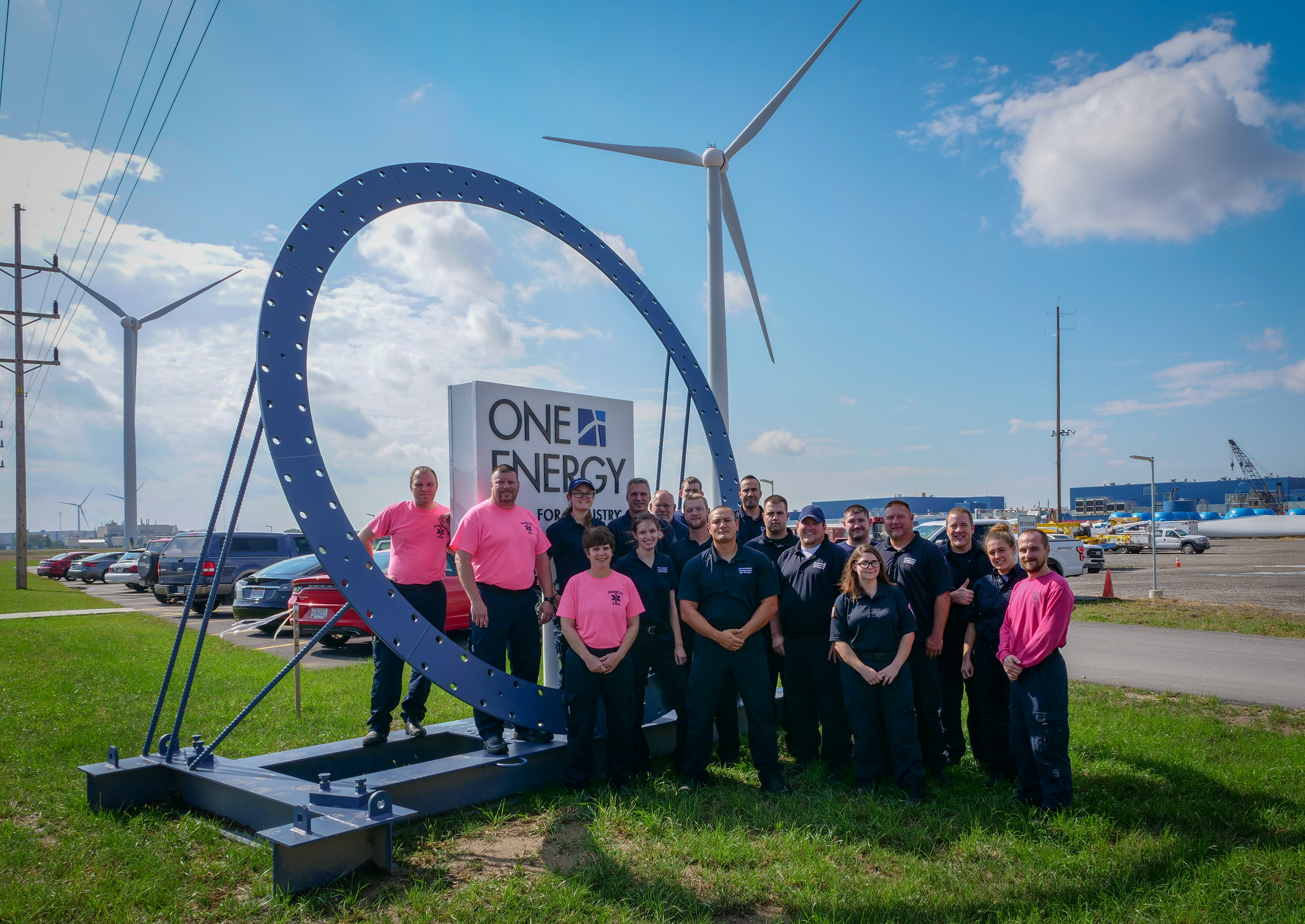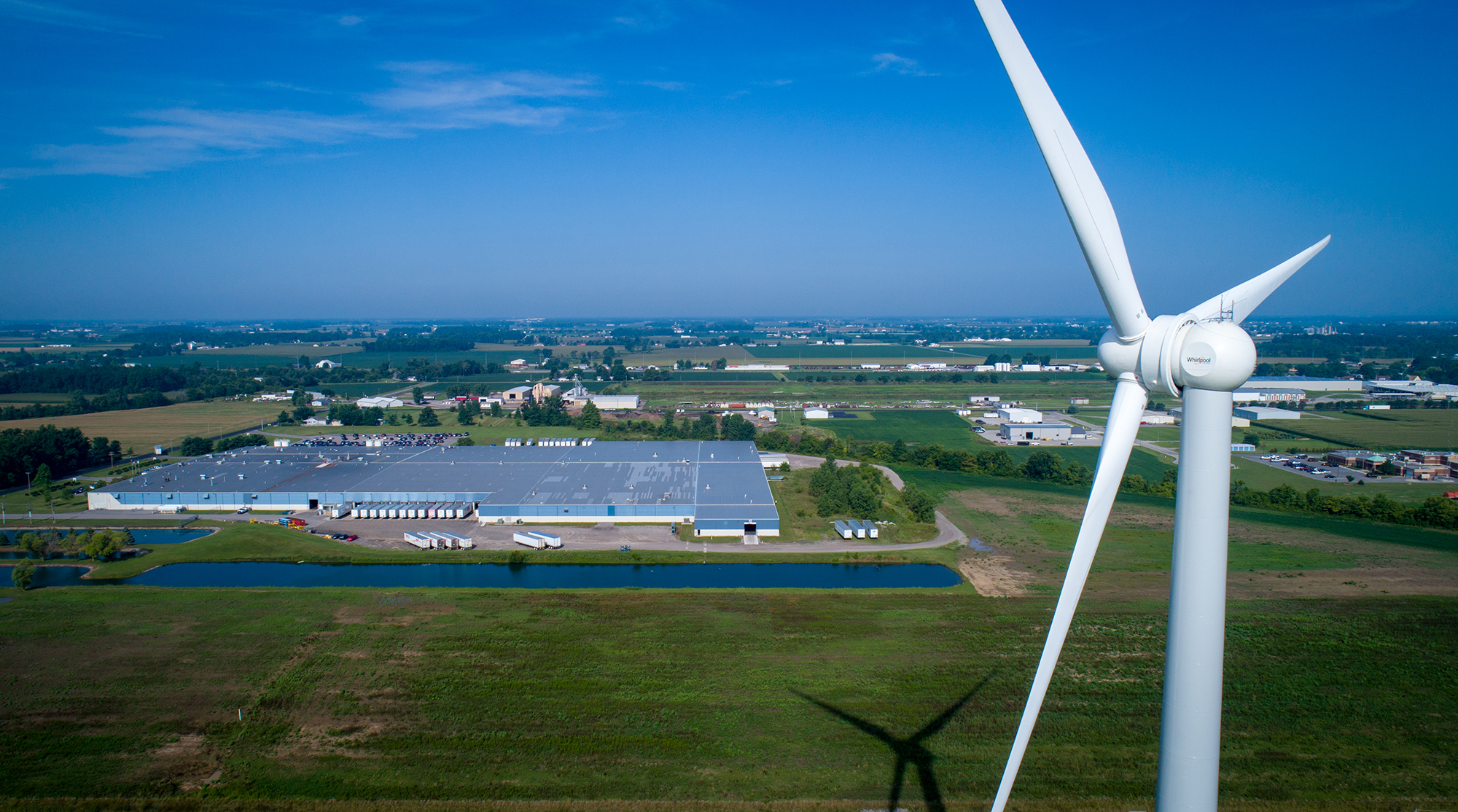SITE PATH
ONE ENERGY FEED

SUBSCRIBE
CONNECT WITH US
News Filters

Welcome to our latest installment of Wind Study, featuring homework problems using 2-D geometry and rates.
On Monday, we asked for your help to determine the length of the ladders inside our utility-scale wind turbines, as well as how long it would take one of our technicians to climb one of these ladders. (If you haven’t read Monday’s question yet, click here.)
The answers to these questions can be downloaded via the link below.
Download this week’s Wind Study Homework Answer
Below, a One Energy employee is pictured climbing the ladder inside a wind turbine tower. (Note that the employee is wearing various gear, which is required to keep climbers safe when working in the turbine.)

For an up-close view of the inside of a One Energy wind turbine, check out our “Virtual Tour of a Wind Farm” below! (Ladder-specific footage begins at 19:35.)
Check back on Monday for a new Wind Study question, which will be posted to our Facebook and Twitter accounts as well!

The investment world is made up of boxes. Capital providers decide which boxes interest them and then hunt for deals that fit the shape. Whether it is a high-rise building, a new energy technology, or even a cutting-edge piece of software, everything gets categorized into a box.
But what happens when you do not fit into a box? What if you have deliberately built a company to break the mold? How do you package your great, albeit oddly shaped, idea in a way that makes a stubborn investment world start to think outside their standard-shaped box?
Wind energy is not a new concept for the investment world. Wind energy is a proven technology that currently makes up 7 percent of the United States’ electricity needs. You wouldn’t think it would be so hard to convince an investor that a wind project will provide a safe, steady return. But One Energy does not do large wind projects that fit into a standard box – we do behind-the-meter, on-site wind. What makes sense for a large wind project that interconnects into the power grid (specifically for the wholesale market), does not necessarily make sense for a Wind for Industry project. As it turns out, when you take a proven technology but apply it in a new and innovative way, the constraints of a standard deal process must be tossed out.
I’ve gone through many rounds of due diligence during the fundraise process. And each time, no matter how much an investor swears they understand our business model is different, they ultimately give us due diligence requests designed to force the deal to look like one the group has already done before. We are constantly squeezed into a standard-sized box. Phrases such as “industry standard” are used frequently.
For example, installing multiple meteorological masts on-site for two years might make sense from a scheduling and financial standpoint for a 100-turbine job that takes years to develop – but it is nearly impossible for a five-turbine job that can take a fraction of the time. LiDAR technology, something the large wind industry is only starting to adopt as a stand-alone data source, is now our go-to for on-site data campaigns due to its deployment flexibility. We have had to adapt our wind resource methods to meet the timeline and financial constraints of on-site wind, while still meeting or exceeding the accuracy required of a large wind project. This has been quite a challenge to explain to investors who claim they want to be a part of the next big thing, but in reality, would much rather stick with the same old thing.
For years, my team has studied the best way to take the existing industry standards and dissect them into the core scientific principles they’re governed by. In our published methodologies, we explain our creative solutions that make Wind for Industry projects possible. The science is the same, the answer is the same, but the process is different. I wish I could spend more time explaining the science behind our impressive methods to potential investors, rather than explaining over and over why it is unreasonable to expect on-site wind to fit into the same box as a large wind project.
Investors and third-party engineers must take the time to listen to the science behind the deal instead of running through a predetermined check list. If you always use the same standard boxes, innovation is impossible. The exact same deals will be funded time and again, industry standard will never be challenged, and out-of-the-box thinking will be nonexistent. Where’s the fun in that?
Jessica Grosso is the Head of Project Planning and Technology at One Energy.

This aerial shot of a wind turbine during construction highlights the grated decks One Energy uses in our turbine towers.
These One Energy employees are standing on the deck of the first tower section, called the “base.” All four tower sections are topped with one of these decks. Unlike other wind turbines with solid, diamond-plated decks, One Energy’s open-grated design allows for better airflow, lighting, and communication while climbing. The decks assist in the construction of the wind turbine, as workers wait to stack each tower section, like in the photo below! (They also act as nice resting spots for technicians as they climb the ladder to the top of the turbine.)
Learn more about One Energy’s patented hanging deck design on our Patents and Trademarks page.
Can’t get enough? Our Head of Construction Chelsea shares more about our patented deck design during our Virtual Tour – deck commentary starts at 18:57.


Happy Monday! Time for another Wind Study – this week we’re talking 2-D geometry and rates.
One Energy’s wind turbines sit upon 80-meter-tall towers, which have a ladder that runs from the basement up to the top deck, just below the nacelle. Employees climb this ladder from time to time, in order to perform maintenance on the turbine. Help us determine the length of this ladder, as well as how long it will take our Technician Justin to climb it!
Download this week’s Wind Study Homework Question (and check back Friday for the answer!) This question can also be found on our Facebook and Twitter accounts.
Have questions about some of the words used in this question, like “nacelle”? Check out webpage 4.1 Energy Terminology.

Introducing Science Shorts! At One Energy, science isn’t just crucial to our jobs, it’s also fun! Join our scientists and engineers on an educational adventure with different activities and concepts to engage with every other week. Explore the real science behind things like the weather, renewable energy, large machinery, and the most fascinating of all: concrete! Follow along to be amazed.
This week: power vs. energy – what’s the difference?
Reporting from the North Findlay Wind Campus, Jessie (our Head of Project Planning & Technology) will explain the difference between power and energy, with real-life examples and help from Senior Analyst Carly.
Learn how power and energy differ, and how they relate to wind turbines and wind energy.
To catch future Science Shorts, be sure to subscribe to our YouTube channel.

It’s Friday – which means it’s time to share the answer to this week’s Wind Study question! (If you haven’t read this week’s question yet, click here.)
This week, we asked for help determining what fraction of One Energy employees are trained as Basic and Advanced Emergency Medical Technicians (EMTs) – and there were some fun permutation questions as well! The answer to these questions can be downloaded via the link below.
Download this week’s Wind Study Homework Answer
At One Energy, we believe that safety and quality are always first, and we encourage all employees to complete EMT training via the One Energy Training Institute. As part of training, we partner with local EMS organizations for clinical rotations and ride-along training. Below, a class of One Energy EMTs and instructors are shown at the North Findlay Wind Campus, following completion of the National Registry of Emergency Medical Technicians (NREMT) examination.

Check back on Monday for a new Wind Study question, which will be posted to our Facebook and Twitter accounts as well!

Introducing Safety Minute, a new series from One Energy!
In this video, Construction Technicians Kerry and Emily walk viewers through the gear needed to stay safe while climbing or working in utility-scale wind turbines.
Published monthly, Our Safety Minute videos will highlight safety tips and features related to what we do at One Energy. We believe that safety and quality are always first, and practicing safety never ends when you’re building Wind for Industry® projects. To make sure you never miss a new release, subscribe to our YouTube channel.

I have a one-year-old. He is a great communicator. He screams in my face when he is hungry or tired and I promptly do whatever it takes to make him stop. Effective communication is one of the first things we learn to do as humans. Yet, as business leaders, with some of the most advanced degrees and greatest minds and innovators in our ranks, we time and time again see ineffective communication causing some of the biggest problems in our companies and are left asking, “why is communication so hard?”
So why IS communication so hard? Let’s face it. Basic communication is not difficult. My toddler has not said a single word in his life, but when he is hungry and mad about it, I know. He yells, he cries, I feed him, and once he’s happy, we move on.
But most businesses aren’t set up to let this kind of free flow of information happen. Instead, logistical and political roadblocks creep in and stop communication dead in its tracks.
First, the logistical roadblocks. These roadblocks involve the realities of business that complicate the flow of information across the enterprise. Unlike a single toddler, there is not one person to communicate with, there are dozens, hundreds, or thousands of people across many departments and geographic locations. There is also not just one message to give. Businesses, especially ones that are growing and changing rapidly, are constantly churning out new information and new or updated strategies on every level.
Then, there are the political roadblocks. The political roadblocks go something like this: “I can’t tell my boss what is happening in my department or there will be blowback.” “I can’t be critical of my boss or I won’t get a raise.” “If I question our goals and strategy, people will think I’m not a team player.” “I’ve seen this happen 1,000 times before, why even bother telling them it’s going to blow up in our face again?”
And there you have it. That’s how communication, which my one-year-old is so good at, is keeping your brilliant team from having clear direction, working strategically toward a common goal, knowing how appreciated they are, or understanding when they’ve made a big mistake. It’s what’s keeping your good company from becoming a great one.
So what do you do about it? Well, there is no silver bullet here. You have to take the time, make the effort, repeat important things, and then do it again, and again, and again. You have to have the hard conversations and insist that others do the same. You have to be able to (figuratively) scream like my toddler when something is going wrong: “look here, this is a problem!”
Communication isn’t sexy. It’s not product innovation. It’s not churning out widgets you can sell to increase revenue. In fact, you’re taking time away from all of those things to do it. But, it may just be the thing that is keeping your good company from being a great one. And, the good news is, it really isn’t that hard.
Katie Treadway is the Head of Regulatory Affairs at One Energy.

Today’s view illustrates what it really means to have on-site wind! At One Energy, we build Wind for Industry projects, which means the turbines are installed near the facility they’re powering. (Notice how this particular wind turbine sits on the same property as the manufacturing facility that it’s providing power to.)
Wind for Industry projects are also “behind the meter,” because the energy feeds directly into the facility, instead of the power grid like traditional wind projects.
Want to dive into the details of Wind for Industry? Click here.


Happy Monday! Time for another Wind Study – this time with fractions and permutations! We need help dividing our teams for work in remote areas, to ensure we have certified Emergency Medical Technicians on site.
Download this week’s Wind Study Homework Question (and check back Friday for the answer!)
This question can also be found on our Facebook and Twitter accounts.




